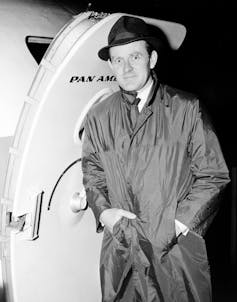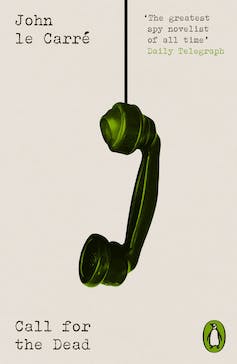I grew up in the southeast of England. There wasn’t all that much to do. I remember spending a lot of time at the local cinema. You had to drive to get there. I watched pretty much anything I could.
Tom Cruise was excellent in Mission: Impossible. Pierce Brosnan was equally great in GoldenEye – James Bond careening through the streets of St Petersburg astride a tank. It was cool, it was funny, it was the mid-1990s.
These films also served as a visual reminder: the Cold War was a thing of the past. Communism was done and dusted, already an impossibly distant memory. The West was well and truly the best.
If I wasn’t watching films, I was reading books. I was not an especially discerning reader. James Joyce, Jilly Cooper. I didn’t really mind.
There were a fair few books at my grandparents’ place, which I always thought of as home. This is where I discovered the work of John Le Carré. I remember being intrigued by the unusual name embossed in gold print on the cover of the volume I’d stumbled upon. It rang a bell: something to do with a secret world of spies.
Here’s a taste of Le Carré’s prose:
When Lady Ann Sercomb married George Smiley towards the end of the war she described him to her astonished Mayfair friends as breathtakingly ordinary. When she left him two years later in favour of a Cuban motor racing driver, she announced enigmatically that if she hadn’t left him then, she never could have done; and Viscount Sawley made a special journey to his club to observe that the cat was out of the bag.
This is the opening paragraph of Le Carré’s debut novel, Call for the Dead. Le Carré wrote the book while living in the same village my grandparents moved to a couple of decades later (Great Missenden).
Published in 1961, this novel ushered into existence the spymaster George Smiley.
Friday essay: the secret lives of Ian Fleming and John Le Carré – the spymasters shaped by a lack of parental love
Instantly hooked on an unlikely hero
A composite based on several real people, George Smiley is Le Carré’s most beloved and influential literary creation. He has been portrayed on screen, to acclaim, by luminaries like Alec Guinness and Gary Oldman.
Guinness played Smiley in the famous 1979 television adaptation of the novel that might well be Le Carré’s masterpiece: Tinker, Tailor, Soldier, Spy, which celebrates its 50th birthday this year. In 2011, Oldman put in a commendable shift as Smiley in the well-received film adaptation.
In this iconic novel, Smiley hunts down a thinly fictionalised version of the infamous MI6 double agent, Kim Philby.
If not for Smiley, we would not have Jackson Lamb, the protagonist of Slow Horses – also, fittingly, played by Oldman in the ongoing televisual adaptation of Mick Herron’s Slough House series.
Best books of 2023: our experts share the books that have stayed with them
Here’s how Le Carré introduces Smiley to his readers:
Short, fat, and of a quiet disposition, he appeared to spend a lot of money on really bad clothes, which hung about his squat frame like skin on a shrunken toad.
Economical, yet evocative. As an initial description, this surely ranks as one of the very best. I was instantly hooked: who was this man, and why describe him this way? And what on earth was going on with those really bad clothes?
Le Carré doesn’t directly address that last question in Call for the Dead. He explains instead that part of George Smiley died after Lady Ann left him:
The part of Smiley which survived was as incongruous to his appearance as love, or a taste for unrecognised poets: it was his profession, which was that of intelligence officer. It was a profession he enjoyed, and which mercifully provided him with colleagues equally obscure in character and origin. It also provided him with what he had once loved best in life: academic excursions into the mysteries of human behaviour, disciplined by the practical application of his own deductions.
Smiley works as an intelligence agent for the Circus, Le Carré’s fictionalised version of Britain’s MI6. Looks can deceive. Despite his undistinguished appearance, Smiley is incredibly good at what he does. This unlikely hero – part bureaucrat, part detective – always gets things done, more often than not in the face of seemingly insurmountable odds.
‘The wilderness of mirrors’: 70 years since the first James Bond book, spy stories are still blurring fact and fiction
From the Cold War to Brexit
Smiley finds himself in a spot of bother at the start of Call for the Dead.
A civil servant called Samuel Fennan has, on the back of a routine security check, committed suicide. Smiley, who oversaw the vetting process, is being scrutinised by his superiors. They think him responsible. Suspecting foul play, Smiley sets up his own investigation.
Despite spending much of the novel in hospital, Smiley hatches a brilliant plan and unravels the truth. Without wishing to spoil the plot: the novel ends with Smiley heading to Zürich in the hope that he can win his wife back.
Le Carré kept coming back to Smiley throughout his career, in eight of his subsequent novels.
Moving from the Cold War to the self-inflicted catastrophe of Brexit, Le Carré’s nine Smiley novels paint a remarkably candid – and increasingly melancholic – portrait of a former imperial power in terminal decline. Smiley knows it’s declining, and that he has wasted his days chasing ghosts – some real, most imagined.
He says so in 1990’s The Secret Pilgrim:
It’s over, and so am I. Absolutely over. Time you rang down the curtain on yesterday’s cold warrior. And please don’t ask me back, ever again. The new time needs new people. The worst thing you can do is imitate us.
What’s a cold war? A historian explains how rivals US and Soviet Union competed off the battlefield
George Smiley is James Bond’s reality check
We can productively compare Le Carré’s creation with his contemporary, James Bond.
Like Le Carré, Ian Fleming had a professional background in espionage. Similarly, Fleming put his firsthand knowledge of tradecraft to good use when writing books.

AP
However, in marked contrast to Le Carré, Fleming rails against the reality of Britain’s diminished status as a world power in the wake of the second world war. His fictional universe is one in which – despite much evidence to the contrary – the Sun somehow refuses to set on the British Empire.
This basically explains James Bond. Fleming conceived of Bond as a blunt instrument, a weaponised literary device capable of reaffirming Britain’s standing as a world power. Bond isn’t really a character, he’s a means to an end. All surface, no feeling. An example of ideological wish fulfilment.
This, in turn, helps us understand the enduring appeal of George Smiley.
Le Carré famously detested Bond. Smiley was the necessary corrective. Overweight, unattractive, a terrible dresser – Smiley is everything Bond is not when it comes to looks. And he has no luck in love whatsoever. Still, it is clear that Le Carré’s leading man has something the woefully insubstantial Bond emphatically lacks: a rich, if conflicted, inner life.
As I said earlier, looks can deceive. The truth is that Bond is boring. He is utterly dull. Crucially, the same could never be said of the well-rounded (no pun intended), all-too-human Smiley.
Ultimately, I concur with Le Carré:
For me, it has to do with depth. Smiley is an Abbey, made up different periods, fashions, and even different religions, not all of them necessarily harmonious. His authority springs from experience, ages of it, compassion, and at root an inconsolable pessimism which gives a certain fatalism to much that he does.
Pessimistic and fatalistic. Driven by compassion. George Smiley, who is slated to appear in a new novel to be written by Le Carré’s son, is a reminder, disguised as fiction, that still waters do indeed run deep. No wonder he’s such a memorable character.




